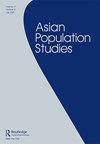Total number of births shrinking faster than fertility rates: fertility quantum decline and shrinking generation size in South Korea
IF 1.5
4区 社会学
Q2 DEMOGRAPHY
引用次数: 1
Abstract
ABSTRACT South Korea’s total fertility rate reached 1.3 in 2001 and hit a record low (0.92) in 2019. The total number of births shrank even faster, recording a 45.9 per cent drop between 2001 and 2019. To understand the declining births and the contributing demographic factors, I decompose the change in the birth rate into mean generation size, fertility quantum, and tempo distortions, and evaluate their relative contributions to the decline. The remarkable birth decline since 2001 is largely explained by fertility quantum decline, especially for second births, and shrinking generation size caused by the decline in female population size. Tempo distortions were strong, but given the marginal change since 2001, they contributed less and only in recent years. This study highlights unique features of East Asia’s low fertility, such as continued fertility decline and the long-term negative effects of reproducing generations’ low fertility. Findings might have implications for developing countries experiencing rapid fertility decline.出生总人数下降速度快于生育率:韩国生育率下降和世代规模缩小
摘要:2001年,韩国的总生育率达到1.3,2019年创下历史新低(0.92)。出生总人数下降得更快,2001年至2019年间下降了45.9%。为了了解出生率下降和人口因素,我将出生率的变化分解为平均世代规模、生育量和节奏扭曲,并评估它们对下降的相对贡献。自2001年以来出生率显著下降的主要原因是生育率下降,尤其是二胎,以及女性人口规模下降导致的世代规模缩小。Tempo扭曲很严重,但考虑到自2001年以来的边际变化,它们的贡献较小,而且仅在最近几年。这项研究强调了东亚低生育率的独特特征,如生育率持续下降和生育后代低生育率带来的长期负面影响。研究结果可能对生育率迅速下降的发展中国家产生影响。
本文章由计算机程序翻译,如有差异,请以英文原文为准。
求助全文
约1分钟内获得全文
求助全文
来源期刊

Asian Population Studies
DEMOGRAPHY-
CiteScore
3.30
自引率
14.30%
发文量
12
期刊介绍:
The first international population journal to focus exclusively on population issues in Asia, Asian Population Studies publishes original research on matters related to population in this large, complex and rapidly changing region, and welcomes substantive empirical analyses, theoretical works, applied research, and contributions to methodology.
 求助内容:
求助内容: 应助结果提醒方式:
应助结果提醒方式:


